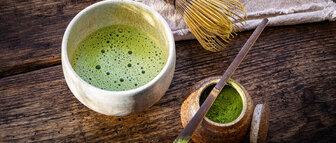Matcha - Japanese green tea ground into a fine green powder is increasingly popular in the world. And as it happens in the world, with the popularity come speculators who offer various imitations under the name matcha.
The EU directive defines matcha as 'green tea which has been produced by grinding the youngest tea leaves from Japan'.
This wording is very imprecise and we cannot agree with it. It leaves room for interpretation and allows, for example, ground sencha made from the leaves to be sold under the name 'matcha' at any time of the year.
In order to bear the name 'matcha', the tea must meet strict criteria at each stage of production.
Growing matcha tea
Matcha is made from the leaves of the tea plant, Camellia sinensis. The tea must be grown and produced in Japan, especially in well-known growing areas such as Uji (Kyoto), Nishio (Aichi), Shizuoka and Kagoshima.
In order for the tea leaves to be suitable for matcha, the bushes must be shaded by a structure built over the tea field for 4 weeks before harvesting. This is done in the spring, at the beginning of the tea growing season, when the tea leaves have the most health benefits.
During shading, the tea plant produces higher levels of chlorophyll and other substances, compensating for the lack of light and increasing the efficiency of photosynthesis. This is what gives the honestly ground tea its distinctive green colour.
Thanks to shading, it contains fewer catechins and has the highest amino acid content of all teas, including L-theanine. L-theanine has a very calming effect, despite the high caffeine content of the leaves.
Harvesting matcha tea
Only the youngest and finest tea leaves (buds) are harvested to ensure a delicate and distinctive flavour.
Processing matcha tea
It must be processed in a factory that is specialised in matcha and different from those that produce traditional Japanese green teas.
The leaves are steamed immediately after harvesting to prevent oxidation and preserve their bright green colour and fresh taste.
The leaves are dried in a kiln called a 'Tencha-ro', which ensures gentler processing and preserves the health benefits of the tea leaves as much as possible.
To improve the texture and taste of the ground matcha, the stems and veins are removed from the leaves. The material processed in this way is called Tencha.
Tencha for our matcha is stored at a temperature of 6 - 7 °C to preserve its qualities. When our order arrives in Japan, it is taken out of the coolers and then ground. We regularly order matcha several times a year, which guarantees the highest possible freshness.
Grinding matcha tea
Tencha is then ground into a fine powder using traditional stone mills. The slow grinding process prevents heat build-up that could affect the flavour and nutrients of the tea.
The production of these granite stones requires great skill and precision. The opposing orientation of the grooves creates a scissor effect and essentially cuts, not grinds, the tenche leaves. These stones need to be serviced regularly and the notches kept in the best possible condition.
One such mill can grind 40-60 g of matcha per hour. The resulting matcha powder particles are 6-7 microns (0.006-0.007 mm) in size.
Genuine matcha is an extremely fine powder with a bright emerald green colour due to its high chlorophyll content.
Why is quality so important in matcha tea?
The high emphasis on quality in this case is not just because of the taste of the tea. When drinking matcha tea, the whole leaves are consumed (not just the water-soluble substances as in infused teas) and therefore quality is very important.
Matcha must have a balanced taste with natural sweetness (umami) and minimal bitterness.
High quality matcha has a creamy and smooth consistency. No additives, sweeteners or preservatives are allowed in its production. Genuine matcha is 100% pure green tea powder.
Matcha is often divided into ceremonial grade (used in traditional tea ceremonies) and culinary grade (used in cooking or in beverages). The ceremonial grade must meet stricter standards for taste and texture.
Matcha that truly meets all of the above criteria also has its fair price. If the price of Matcha is suspiciously low, or the colour is not distinctly green when opened, most likely it is old matcha, or it is not matcha, but just green tea of questionable quality ground to a powder.
In Japan, the traditional production of matcha tea is deeply rooted in history and tradition. Some regions, such as Uji, have a Protected Geographical Origin (GI) designation. This ensures authenticity and quality while preventing mislabelling of products from other regions or countries.
By meeting these criteria, matcha retains its status as a revered and authentic Japanese tea.
